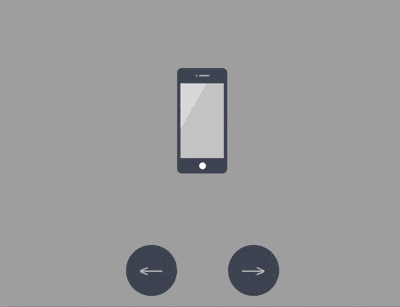 ウェブフロントエンド
ウェブフロントエンド
 CSSチュートリアル
CSSチュートリアル
 CSS と Vanilla.js を使用して Apple デバイスを表示するインタラクティブなアニメーションを実装する方法 (ソース コードを添付)
CSS と Vanilla.js を使用して Apple デバイスを表示するインタラクティブなアニメーションを実装する方法 (ソース コードを添付)
CSS と Vanilla.js を使用して Apple デバイスを表示するインタラクティブなアニメーションを実装する方法 (ソース コードを添付)
この記事の内容は、CSS と Vanilla.js を使用して Apple デバイスを表示するためのインタラクティブなアニメーションを実装する方法に関するものです (ソースコードが添付されています)。必要な方は参考にしていただければと思います。助けになる。
エフェクトのプレビュー

ソース コードのダウンロード
https://github.com/comehope/front-end-daily -challenges
コード解釈
iphone、mini、ipad、macbook、imacの5つのデバイスを表す5つのサブ要素を含むdomを定義します:
<div> <div></div> <div></div> <div></div> <div></div> <div></div> </div>
中央表示:
body {
margin: 0;
height: 100vh;
display: flex;
align-items: center;
justify-content: center;
background-color: #aaa;
}コンテナ内の子要素のレイアウトを設定します:
.container {
position: relative;
display: flex;
flex-direction: column;
align-items: center;
}デバイスの共通プロパティを設定します。線形グラデーション パターンが画面の背景として使用されます:
.device {
box-sizing: border-box;
position: relative;
display: flex;
justify-content: center;
background: linear-gradient(120deg, #ddd 30%, #ccc 30%);
}
.device::before,
.device::after {
content: '';
position: absolute;
}iphone、mini、ipad 上部のカメラ、センサー開口部、下部のボタンを備えた形状は似ているため、これらの共通の属性を一緒に設定できます。上部の詳細を描画するには ::before 擬似要素を使用します。 ::疑似要素の後、一番下のボタンを描画します:
.iphone::before,
.mini::before,
.ipad::before {
width: 2px;
height: 2px;
border-style: solid;
border-color: #a5adbe;
border-width: 0 12px 0 2px;
}
.iphone::after,
.mini::after,
.ipad::after {
width: 8px;
height: 8px;
background-color: white;
border-radius: 50%;
}次にデバイスを 1 つずつ描画します。最初に iPhone の輪郭を描画します:
.iphone {
width: 59px;
height: 124px;
border: #484f5e solid;
border-width: 18px 4px;
border-radius: 6px;
}iPhone の上部と下部の詳細を配置します:
.iphone::before {
top: -10px;
}
.iphone::after {
bottom: -13px;
}同様に、ミニを描画します:
.mini {
width: 93px;
height: 138px;
border: #484f5e solid;
border-width: 14px 5px;
border-radius: 10px;
}
.mini::before {
top: -8px;
}
.mini::after {
bottom: -11px;
}次に iPad を描画します:
.ipad {
width: 134px;
height: 176px;
border: #484f5e solid;
border-width: 18px 13px;
border-radius: 12px;
}
.ipad::before {
top: -10px;
}
.ipad::after {
bottom: -13px;
}次に MacBook を描画し、最初に画面を描画します:
.macbook {
width: 234px;
height: 155px;
border: 8px solid #484f5e;
border-radius: 7px 7px 0 0;
}Use ::before 疑似要素を使用してカメラを描画します:
.macbook::before {
width: 294px;
height: 14px;
background-color: #e8ebf0;
top: calc(100% + 8px);
border-radius: 0 0 14px 14px;
}Use : :疑似要素の後 ホストを描画します:
.macbook::after {
width: 3px;
height: 3px;
background-color: #a5adbe;
top: -6px;
border-radius: 50%;
}次に imac を描画します。まず画面を描画します。境界線が残るため、画面の左、上、右の黒い境界線は描画されません。端点にベベルがあるので変更します。 box-shadow を使用して次のことを実現します。
.imac {
width: 360px;
height: 215px;
border-radius: 10px;
box-shadow:
inset 0 14px #484f5e,
inset 14px 0 #484f5e,
inset -14px 0 #484f5e;
border-bottom: 33px solid #e8ebf1;
transform: translateY(14px);
}Use ::before pseudo-element を使用して台形の底面を描画します。
.imac::before {
width: 90px;
height: 0;
top: calc(100% + 33px);
border: solid transparent;
border-bottom-color: #e2e4e8;
border-width: 0 10px 47px 10px;
}Use ::after pseudo -要素を使用して、画面の上部にカメラを、下部にボタンを描画します。 注: ボタンは box-shadow を使用して実装されています:
.imac::after {
width: 4px;
height: 4px;
background-color: #a5adbe;
top: 5px;
border-radius: 50%;
box-shadow: 0 191px 0 4px #464e5d;
} この時点で、デバイスは完全に描画されています。
iPhone 以外の他のデバイスの dom 要素を削除し、1 つの dom 要素だけを残します。これ以降のすべてのアニメーション効果は、この dom 要素で変更されます。
<div>
<div></div>
<!-- <div class="device mini"></div>
<div class="device ipad"></div>
<div class="device macbook"></div>
<div class="device imac"></div> -->
</div>コンテナのサイズを設定すると、子要素が垂直方向の中央に配置されます。デバイスの高さはコンテナの高さの 75% を占めます:
.container {
width: 360px;
height: 350px;
justify-content: center;
}
.device {
transform: translateY(-25%);
}それぞれ .left と .right で表される 2 つのボタン要素を dom に追加します:
<div> <div></div> <div> <span></span> <span></span> </div> </div>
ボタン:
.buttons {
position: absolute;
width: inherit;
font-size: 30px;
height: 2em;
bottom: 0;
display: flex;
justify-content: space-around;
}
.buttons > * {
position: relative;
width: 4em;
}ボタンは左右の矢印です:
.buttons > *::before {
position: absolute;
}
.buttons .left::before {
content: '←';
right: 0;
}
.buttons .right::before {
content: '→';
}ボタンのスタイルを円形に設定します:
.buttons > *t::before {
position: absolute;
width: 2em;
height: 2em;
background-color: #484f5e;
color: silver;
text-align: center;
line-height: 2em;
border-radius: 1em;
cursor: pointer;
}マウス ホバー効果を追加します:
.buttons > *::before {
transition: 0.2s;
}
.buttons .left:hover::before {
width: 4em;
content: '⟵';
}
.buttons .right:hover::before {
width: 4em;
content: '⟶';
}追加ボタンのクリック効果:
.buttons > *:active {
transform: scale(0.9);
filter: brightness(0.8);
}この時点で、ボタンが作成され、対話型スクリプトが作成されます。
要素を取得する関数を定義$:
const $ = (className) => document.getElementsByClassName(className)[0]
デバイス名を格納する配列を定義:
let devices = ['iphone', 'mini', 'ipad', 'macbook', 'imac']
クリック動作のデータ処理方法を定義、左のボタンをクリックすると、配列の左端の要素が右端に移動します。逆に、右のボタンをクリックすると、配列の右端の要素が左端に移動します。そのため、2 方向がループします。配列:
let loop = {
'left': () => devices.unshift(devices.pop()),
'right': () => devices.push(devices.shift())
}クリック イベントを定義し、配列の変更に従ってデバイスを切り替えます:
Array.from($('buttons').children).forEach(element =>
element.addEventListener('click', function(e) {
loop[e.target.className]()
$('device').className = 'device ' + devices[0]
})
)最後に、デバイス切り替えのイージング効果を設定します:
.device,
.device::before,
.device::after {
transition: 0.4s cubic-bezier(0.5, 1.7, 0.5, 1.2);
}終わり!
以上がCSS と Vanilla.js を使用して Apple デバイスを表示するインタラクティブなアニメーションを実装する方法 (ソース コードを添付)の詳細内容です。詳細については、PHP 中国語 Web サイトの他の関連記事を参照してください。

ホットAIツール

Undresser.AI Undress
リアルなヌード写真を作成する AI 搭載アプリ

AI Clothes Remover
写真から衣服を削除するオンライン AI ツール。

Undress AI Tool
脱衣画像を無料で

Clothoff.io
AI衣類リムーバー

AI Hentai Generator
AIヘンタイを無料で生成します。

人気の記事

ホットツール

メモ帳++7.3.1
使いやすく無料のコードエディター

SublimeText3 中国語版
中国語版、とても使いやすい

ゼンドスタジオ 13.0.1
強力な PHP 統合開発環境

ドリームウィーバー CS6
ビジュアル Web 開発ツール

SublimeText3 Mac版
神レベルのコード編集ソフト(SublimeText3)

ホットトピック
 7536
7536
 15
15
 1379
1379
 52
52
 82
82
 11
11
 21
21
 86
86
 HTML、CSS、およびJavaScriptの役割:コアの責任
Apr 08, 2025 pm 07:05 PM
HTML、CSS、およびJavaScriptの役割:コアの責任
Apr 08, 2025 pm 07:05 PM
HTMLはWeb構造を定義し、CSSはスタイルとレイアウトを担当し、JavaScriptは動的な相互作用を提供します。 3人はWeb開発で職務を遂行し、共同でカラフルなWebサイトを構築します。
 VueでBootstrapの使用方法
Apr 07, 2025 pm 11:33 PM
VueでBootstrapの使用方法
Apr 07, 2025 pm 11:33 PM
vue.jsでBootstrapを使用すると、5つのステップに分かれています。ブートストラップをインストールします。 main.jsにブートストラップをインポートしますブートストラップコンポーネントをテンプレートで直接使用します。オプション:カスタムスタイル。オプション:プラグインを使用します。
 ブートストラップにスプリットラインを書く方法
Apr 07, 2025 pm 03:12 PM
ブートストラップにスプリットラインを書く方法
Apr 07, 2025 pm 03:12 PM
ブートストラップスプリットラインを作成するには2つの方法があります。タグを使用して、水平方向のスプリットラインを作成します。 CSS Borderプロパティを使用して、カスタムスタイルのスプリットラインを作成します。
 ブートストラップに写真を挿入する方法
Apr 07, 2025 pm 03:30 PM
ブートストラップに写真を挿入する方法
Apr 07, 2025 pm 03:30 PM
ブートストラップに画像を挿入する方法はいくつかあります。HTMLIMGタグを使用して、画像を直接挿入します。ブートストラップ画像コンポーネントを使用すると、レスポンシブ画像とより多くのスタイルを提供できます。画像サイズを設定し、IMG-Fluidクラスを使用して画像を適応可能にします。 IMGボーダークラスを使用して、境界線を設定します。丸い角を設定し、IMGラウンドクラスを使用します。影を設定し、影のクラスを使用します。 CSSスタイルを使用して、画像をサイズ変更して配置します。背景画像を使用して、背景イメージCSSプロパティを使用します。
 ブートストラップのフレームワークをセットアップする方法
Apr 07, 2025 pm 03:27 PM
ブートストラップのフレームワークをセットアップする方法
Apr 07, 2025 pm 03:27 PM
Bootstrapフレームワークをセットアップするには、次の手順に従う必要があります。1。CDNを介してブートストラップファイルを参照してください。 2。独自のサーバーでファイルをダウンロードしてホストします。 3。HTMLにブートストラップファイルを含めます。 4.必要に応じてSASS/LESSをコンパイルします。 5。カスタムファイルをインポートします(オプション)。セットアップが完了したら、Bootstrapのグリッドシステム、コンポーネント、スタイルを使用して、レスポンシブWebサイトとアプリケーションを作成できます。
 ブートストラップボタンの使用方法
Apr 07, 2025 pm 03:09 PM
ブートストラップボタンの使用方法
Apr 07, 2025 pm 03:09 PM
ブートストラップボタンの使用方法は?ブートストラップCSSを導入してボタン要素を作成し、ブートストラップボタンクラスを追加してボタンテキストを追加します
 ブートストラップの日付を表示する方法
Apr 07, 2025 pm 03:03 PM
ブートストラップの日付を表示する方法
Apr 07, 2025 pm 03:03 PM
回答:ブートストラップの日付ピッカーコンポーネントを使用して、ページで日付を表示できます。手順:ブートストラップフレームワークを紹介します。 HTMLで日付セレクター入力ボックスを作成します。ブートストラップは、セレクターにスタイルを自動的に追加します。 JavaScriptを使用して、選択した日付を取得します。




